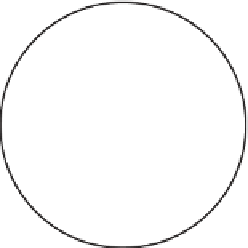Geoscience Reference
In-Depth Information
Box 2.1
Tide generating forces
To understand how the forces generating the tides arise, we shall examine the tidal
forces due to the Moon, which exerts more than twice the tidal influence of the Sun.
Consider first the balance of forces which keeps the Moon in its almost circular orbit
as it revolves around the mutual centre of gravity of the Earth-Moon system which is
the point labelled C
g
in
Fig. B2.1
.
d
R
R
C
g
ω
C
g
Moon
Earth
Figure B2.1
The Earth and Moon revolving about their mutual centre of gravity C
g
. Thick
white arrows indicate gravitational attraction; black arrows are centrifugal forces.
Because the mass of the Earth, E, is much greater than the mass of the Moon
(
M
81), C
g
is located within the Earth but it is important to remember that
the Earth as well as the Moon revolves about C
g
, albeit in a much smaller circle.
The Moon remains in its orbit because of a balance between the mutual gravitational
attraction of the Earth and the Moon on the one hand and the centrifugal force
acting on the Moon on the other, a balance which can be expressed as:
'
E
=
GME
d
2
MR
0
o
2
Gravitational attraction
¼
¼
¼
Centrifugal force
ð
2
:
17
Þ
10
11
m
3
kg
1
s
2
is the gravitational constant, d
where G
384 000 km is
the distance between the centres of the Earth and the Moon, R
0
, is the distance between
the centre of gravity C
g
and the centre of the Moon and o
¼
6.674
10
6
s
1
is the
¼
2.463
angular speed of the Moon's orbit.
What is not quite so obvious is that there is an equivalent balance between the
forces acting on the Earth, which can be written as



























Search WWH ::

Custom Search